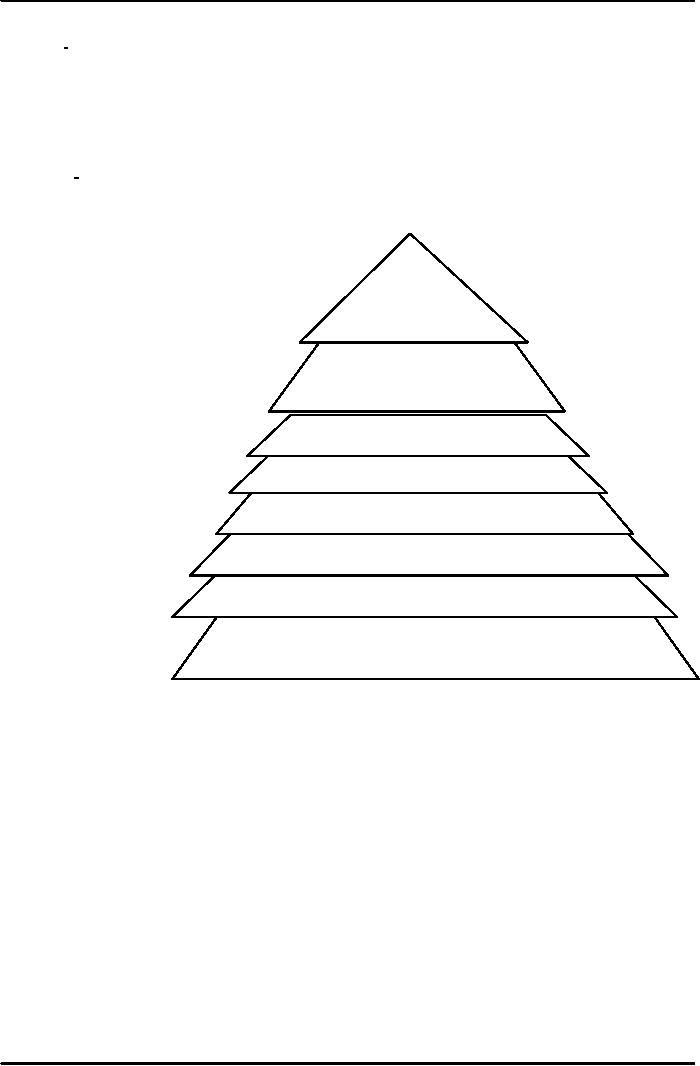 |

Introduction
to Psychology PSY101
VU
Lesson
26
SECONDARY/
LEARNT/ PSYCHOLOGICAL MOTIVES
�
Besides
the basic biological needs, the
expression of psychological needs is
also of great
significance:
through
society and culture in which
one lives.
�
Non-satisfaction
of these motives may lead to
mental illness.
Main
psychological needs
are:
i.
Achievement
ii.
Curiosity
iii.
Need for appraisal
iv.
Need for
affiliation
v.
Need for
power
vi.
Work as motive
1.Achievement
�
Self-
actualization or attaining excellence in relevant
domain is the characteristic feature
of
this
motive.
�
The
need to achieve something,
some object of desire, a goal, or
position/status.
�
The
source of satisfaction is not
just the achievement of the goal,
but the very act of
striving
for
it too.
�
The
level of the need for achievement
varies from person to
person.
�
Some
are high and some
low achievers.
�
Competition
is an important element of this
need.
�
Achievement
motivation is a significant variable in a competitive
society.
�
People
with high motivation: Take
and overcome challenges in
order to succeed rather
than
finding
an easy ways of achieving
success.
�
People
with low motivation: Tends
to avoid failure, finding easy
way outs, not desire to
take
difficult
tasks.
�
Methods
of measuring achievement
motivation:
�
Thematic
Apperception Test (TAT) is
used; series of ambiguous
pictures are presented
to
the
person and ask him to
write a story on it.
�
Instructions
are given as that the story must
have a beginning, middle and an
end along with
the
title; who are the people, what they
are thinking, feeling, wanting etc; what
is going on
and
what will happen____ all depicts the
needs, desires and
motivation to succeed/
achieve.
�
In short the
subject describes the past,
present and future along
with the description of
characters
and their thinking and
motivation.
�
Factors
Contributing to the Need for
Achievement
o
Parents
who are warm for
their child as well as make
high standards for
their
child;
encouragement is given on becoming
independent.
o
Siblings
who are high achievers in
their own domain.
2.
Curiosity
�
Think
why a little child always
wanting to break toys and
things?
�
Why
children always asks
questions of things they saw on TV,
read it or listen from any
one
�
It is
all their curiosity and need
to explore in order to find answers of
these puzzles.
�
It is a
significantly inborn but learned
also: found in both humans
and animals.
�
Parents
encourage their children's curiosity by
satisfying their
inquisitiveness.
�
School
also plays an important role; the
teaching methodology adopted may
encourage or discourage
curiosity.
3.Symbolic
Reward/ Appraisal
�
Appraisal
is a powerful motive for
everyone; especially for
children and animals
�
Praising
words, petting after doing
well etc all serve as
symbolic reward for the
learner.
�
The
presence and the attitude of the
more liked serves as a
social reward for the
learner
e.g. child with his
mother, dog with its
caretaker etc.
152

Introduction
to Psychology PSY101
VU
�
Parent's
approval and disapproval, liking and
disliking towards the child
all are
included
in symbolic rewards.
4.
Need for
affiliation
�
Urge/
desire to main a relationship with
other people; making friends, social
contact with other
people.
�
Less
desire to be isolated or
alone.
�
Studies
showed that females spend a
larger span of time among friends
and peers as compared
to
males.
�
Although
the need for affiliation is a
universal phenomenon, cultural differences do
exist in its
expression;
some cultures have more
group cohesiveness than
others.
5.
Need for Power
�
Desire
to influence, hold or ruling over
others in order to be recognized as
powerful individual.
�
These
types of people prefer to work in big
organizations, businesses and
other influential
professions.
�
There
also exists gender
differences among males and
females; men are more apt to
take challenges
and
respond quite aggressively
irrespective of women who
are socially restrained and
traditional in
her
behavior.
6.
Work
�
Most
of the people spent large span of time in
their life at work; for this
reason, psychologists take
it
as
another powerful motive
�
Work
serves as a powerful motive
because it satisfies other
motives also such as
biological motives of
hunger,
shelter etc, sense of
achievement, affiliation and
decision-making.
Theories/Explanations
of Motivation
i.
Instinct Approaches
ii.
Drive-reduction Approaches
iii.
Arousal Approaches
iv.
Incentive Approaches
v.
Cognitive Approaches
vi.
Maslow's Hierarchy of
Needs
Different
approaches that focus upon
the biological, social, cognitive, and
psychological factors.
i.
Instinct Theory
�
There
is a biologically determined behavior pattern
that we are born with,
known as instincts;
biological
variables
drive our behavior.
�
All
humans and animals exhibit
certain innate tendencies, which
are fixed, predetermined,
and unlearned.
�
Different
behaviors are respective
responses to specific
instincts.
�
Instincts
are essential for the survival of the
species.
�
Instincts
provide energy for action
thus directing organism's
behavior.
Shortcomings
of Instinct Approaches
�
Which
are the primary and power instincts...18
as William Mc Dougall said
or5759as Bernard
proposed.
�
If
instincts are the main
driving force, then how come
different people behave differently under
the
influence
of the same instinct? e.g. hunger or
heat.
.
ii.
Drive-
Reduction Theory
�
Our
biological/ physiological needs create an
aroused or tension producing state
that motivates us to
fulfill
them.
�
When
the basic biological requirements
are lacking, and the need is
unfulfilled, then drive/
arousal is
produced
in the organism energizing it to obtain
the requirement in order to satisfy the
need.
Drive:
An
arousal or motivational tension that
provides energy for action or
behavior.
153

Introduction
to Psychology PSY101
VU
Homeostasis:
A
stable, well-maintained state of internal
biological balance is required for the
proper
functioning
of the body; homeostasis is the process
whereby this balance is
maintained.
Primary
and Secondary
Drives
Primary
Drives:
Entirely biological in nature
i.e. hunger, thirst, sleep,
sex, air etc
Primary
drives are satisfied by
reducing the underlying need
e.g. hunger followed by food,
thirst followed by
water.
Secondary
Drives: These
are psychological as well as
social in nature. Prior learning
and experiences are
what
brings
about such needs e.g.
academic achievement.
Criticism
�
What
about behaviors directed
towards maintenance, and
even heightened, arousal?
�
What
about curiosity or risk-taking behavior?
�
Is
our behavior guided by drive-reduction
alone, or by our goals
too?
iii.
Arousal
Theory
�
A
certain level of arousal and
excitement is needed by our
system.
�
We
try to maintain that level of stimulation
and activity; the maintenance
may require off and on
reduction
or
increase in the existing level, depending upon the
circumstances.
�
When
our arousal state becomes
too high, it needs to come
down for optimal functioning
and vice versa.
�
Too
high a motivational arousal
may affect performance negatively; it
may produce anxiety and
irritability in
the
organism.
�
Similarly
too low an arousal may
also have adverse effect
e.g. performance of a person suffering
from
depression.
�
A
consistent, well balanced,
and leveled arousal is
needed for the optimal
functioning e.g. in case of
exams,
athletics,
interviews.
iv.
Incentive Theory
�
Motivational
state of the organism is understood and
explained in terms of positive or
negative
environmental
stimuli.
�
As
opposed to the drive- reduction
and arousal theory, this
theory explains motivation in
terms of external
events
that stimulates/ energizes the organism's
behavior, rather than innate instincts or
drives.
�
Characteristics
of the external environment are important
variables in a person's
motivation.
�
Incentives
are rewards that energize
and drive our
behavior.
�
Any
thing that provides us with a
reward triggers motivation
for action.
�
Incentives
may generate behavior even
in the absence of an active, un
satisfied, instinct or drive
e.g. how
can
we eat a bowl full of ice
cream even.
�
When
our stomach is full after a
heavy meal?
�
But in
many cases drives and
incentives go together and have a
deeper effect.
Criticism
�
What
about the motivational process when an
individual tries to fulfill
needs although there is no
apparent
incentive
present? E.g. working even
when paid very little, and the
job too is not matching
with one's
aptitude.
�
What
about behaviors when there is no
apparent incentive available, in fact threat is
involved? e.g.
helping
the
people stranded in a house on
fire.
v.
Cognitive Theory of
Motivation
Theories
that give importance to the cognitive
processes of the individual in explaining
motivational process;
thoughts,
feelings, expectations, understanding and
evaluating all are important when
explaining the
motivation
of the person.
154

Introduction
to Psychology PSY101
VU
Expectancy-
Value Theory
Two
types of cognitive processes underlie
human behavior.
I.
Expectation:
The
expectation, hope, or anticipation that
our behavior will help us
attain a certain goal.
II.
Value:
The
perception, appraisal, or understanding of the value
of the goal to us.
�
The
level of expectation and the value
attached to it, together, determine the
level of motivation.
�
In
case of a high expectation along with
high value, the motivation
will also be higher.
�
But if
any of the two is weak or
low, the corresponding motivation will
also be low
�
Can
you see the two operating in your
exam and study
behavior?????
Intrinsic
and Extrinsic Motivation
Cognitive
theories differentiate between
intrinsic and extrinsic
motivation.
Intrinsic
motivation: Motivation
from within, or Internal
motivation that energizes the
person to satisfy or
accomplish
the goal; the goal is to attain enjoyment
and personal satisfaction, in
which no external tangible
reward
is involved e.g. altruistic
behavior.
Extrinsic
motivation: Revolves
around the tangible rewards such as money,
social contacts.
�
Studies
shows that intrinsic
motivation produces better results in
terms of performance than the
extrinsic
motivation.
�
When
extrinsic motivation is more for the
desired behavior than the
intrinsic one, and it
remains like that
for
long, then the intrinsic
motivation eventually declines.
�
e.g. a
child has been given reward
for doing neat and
tidy homework, as he is less
intrinsically motivated;
eventually
the entire focus of the child in getting
reward after doing tidy
homework rather than doing
it
otherwise.
�
Teachers
and parents should use extrinsic
motivation, but with great
care.
�
Extrinsic
motivation can be used to
enhance the motivational level but
not at the cost of
intrinsic
motivation.
vi.
Abraham Harold Maslow:
1908-1970
�
American
psychologist and leading
exponent of humanistic
approach
�
Gave
comprehensive theory of
motivation.
�
Found
the prevalent psychology to be too
pessimistic and negatively
oriented.
Key
Points of Maslow's Theory
�
Psychology
and the psychologist should look at the
positive side of the human
beings.
�
There
must be more to living than
just being battered by a hostile
environment, or by depraved
instincts----
which
may actually be leading to
self-destruction.
�
People's
needs are not low level
and base. We have positive
needs that
may
become neutral in the worst cases, but
will not turn negative
or
base.
�
Human
behavior does respond to
needs but we will be wrong
in
Self
saying
that all our needs
are only physiological in
nature
Actualiza
�
Needs
motivate human action; such
needs are very few in
tion
number.
Maslow's
Hierarchy of Needs
Esteem
�
Basically
a stage theory.
�
The
needs at one level have to be
met in order for one
to
move
on to higher order.
Love
and Belongingness
�
The
needs at the lowest/primary/base level
are the
physiological
needs, whereas the highest
order needs
are
the self-actualization needs.
Safety
�
Self-Actualization: Most
advanced human need
based
on the desire to grow and
utilize one's
potential
up to the optimal level.
Physiological
Needs
155

Introduction
to Psychology PSY101
VU
Categories
of Needs
Metaneeds:
based on a desire to grow rather than
for meeting a deficiency:
expressed in the need for
self
actualization
Deficiency
needs: The
absence of the underlying requirements
triggers these needs e.g.
physiological needs,
love
needs, or esteem
needs
Interactions
and needs of Behavior
Physiological
needs: Fulfilled
through: hunger/food; Pathology
associated=over eating,
anorexia
Safety
needs:
Fulfilled through: profession,
job; Pathology associated=
Phobias
Love
and belongingness Fulfilled
through: Marriage, friendship; Pathology
associated= Antisocial personality
Esteem
needs: Fulfilled
through: Awards, honors, scholarships;
Pathology associated =Depression
Self-actualization
needs: Fulfilled
through: Painting, writing,
singing:
Pathology
Associated
=Isolation,
alienation, cynicism.
If
expanded, Maslow's hierarchy
would appear like
this:
Transcendenc
Criticism
against Maslow's theory
e:
Although
a comprehensive and well
formed
theory,
it has been criticized at
some
points:
�
Can we
actually, for all
case,
Self-actualization:
fulfilling
distribute
and neatly order
these
Potential,
having meaningful
needs?
l
�
There
is little empirical
Esthetic
Needs: order,
evidence
to
support
Maslow's
way of ranking
Cognitive
needs.
Esteem
Needs
Attachment
Needs
Safety
Needs
Biological/Physiological
Needs
156
Table of Contents:
- WHAT IS PSYCHOLOGY?:Theoretical perspectives of psychology
- HISTORICAL ROOTS OF MODERN PSYCHOLOGY:HIPPOCRATES, PLATO
- SCHOOLS OF THOUGHT:Biological Approach, Psychodynamic Approach
- PERSPECTIVE/MODEL/APPROACH:Narcosis, Chemotherapy
- THE PSYCHODYNAMIC APPROACH/ MODEL:Psychic Determinism, Preconscious
- BEHAVIORAL APPROACH:Behaviorist Analysis, Basic Terminology, Basic Terminology
- THE HUMANISTIC APPROACH AND THE COGNITIVE APPROACH:Rogers’ Approach
- RESEARCH METHODS IN PSYCHOLOGY (I):Scientific Nature of Psychology
- RESEARCH METHODS IN PSYCHOLOGY (II):Experimental Research
- PHYSICAL DEVELOPMENT AND NATURE NURTURE ISSUE:Nature versus Nurture
- COGNITIVE DEVELOPMENT:Socio- Cultural Factor, The Individual and the Group
- NERVOUS SYSTEM (1):Biological Bases of Behavior, Terminal Buttons
- NERVOUS SYSTEM (2):Membranes of the Brain, Association Areas, Spinal Cord
- ENDOCRINE SYSTEM:Pineal Gland, Pituitary Gland, Dwarfism
- SENSATION:The Human Eye, Cornea, Sclera, Pupil, Iris, Lens
- HEARING (AUDITION) AND BALANCE:The Outer Ear, Auditory Canal
- PERCEPTION I:Max Wertheimer, Figure and Ground, Law of Closure
- PERCEPTION II:Depth Perception, Relative Height, Linear Perspective
- ALTERED STATES OF CONSCIOUSNESS:Electroencephalogram, Hypnosis
- LEARNING:Motor Learning, Problem Solving, Basic Terminology, Conditioning
- OPERANT CONDITIONING:Negative Rein forcer, Punishment, No reinforcement
- COGNITIVE APPROACH:Approach to Learning, Observational Learning
- MEMORY I:Functions of Memory, Encoding and Recoding, Retrieval
- MEMORY II:Long-Term Memory, Declarative Memory, Procedural Memory
- MEMORY III:Memory Disorders/Dysfunctions, Amnesia, Dementia
- SECONDARY/ LEARNT/ PSYCHOLOGICAL MOTIVES:Curiosity, Need for affiliation
- EMOTIONS I:Defining Emotions, Behavioral component, Cognitive component
- EMOTIONS II:Respiratory Changes, Pupillometrics, Glandular Responses
- COGNITION AND THINKING:Cognitive Psychology, Mental Images, Concepts
- THINKING, REASONING, PROBLEM- SOLVING AND CREATIVITY:Mental shortcuts
- PERSONALITY I:Definition of Personality, Theories of Personality
- PERSONALITY II:Surface traits, Source Traits, For learning theorists, Albert Bandura
- PERSONALITY III:Assessment of Personality, Interview, Behavioral Assessment
- INTELLIGENCE:The History of Measurement of Intelligence, Later Revisions
- PSYCHOPATHOLOGY:Plato, Aristotle, Asclepiades, In The Middle Ages
- ABNORMAL BEHAVIOR I:Medical Perspective, Psychodynamic Perspective
- ABNORMAL BEHAVIOR II:Hypochondriasis, Conversion Disorders, Causes include
- PSYCHOTHERAPY I:Psychotherapeutic Orientations, Clinical Psychologists
- PSYCHOTHERAPY II:Behavior Modification, Shaping, Humanistic Therapies
- POPULAR AREAS OF PSYCHOLOGY:ABC MODEL, Factors affecting attitude change
- HEALTH PSYCHOLOGY:Understanding Health, Observational Learning
- INDUSTRIAL/ORGANIZATIONAL PSYCHOLOGY:‘Hard’ Criteria and ‘Soft’ Criteria
- CONSUMER PSYCHOLOGY:Focus of Interest, Consumer Psychologist
- SPORT PSYCHOLOGY:Some Research Findings, Arousal level
- FORENSIC PSYCHOLOGY:Origin and History of Forensic Psychology